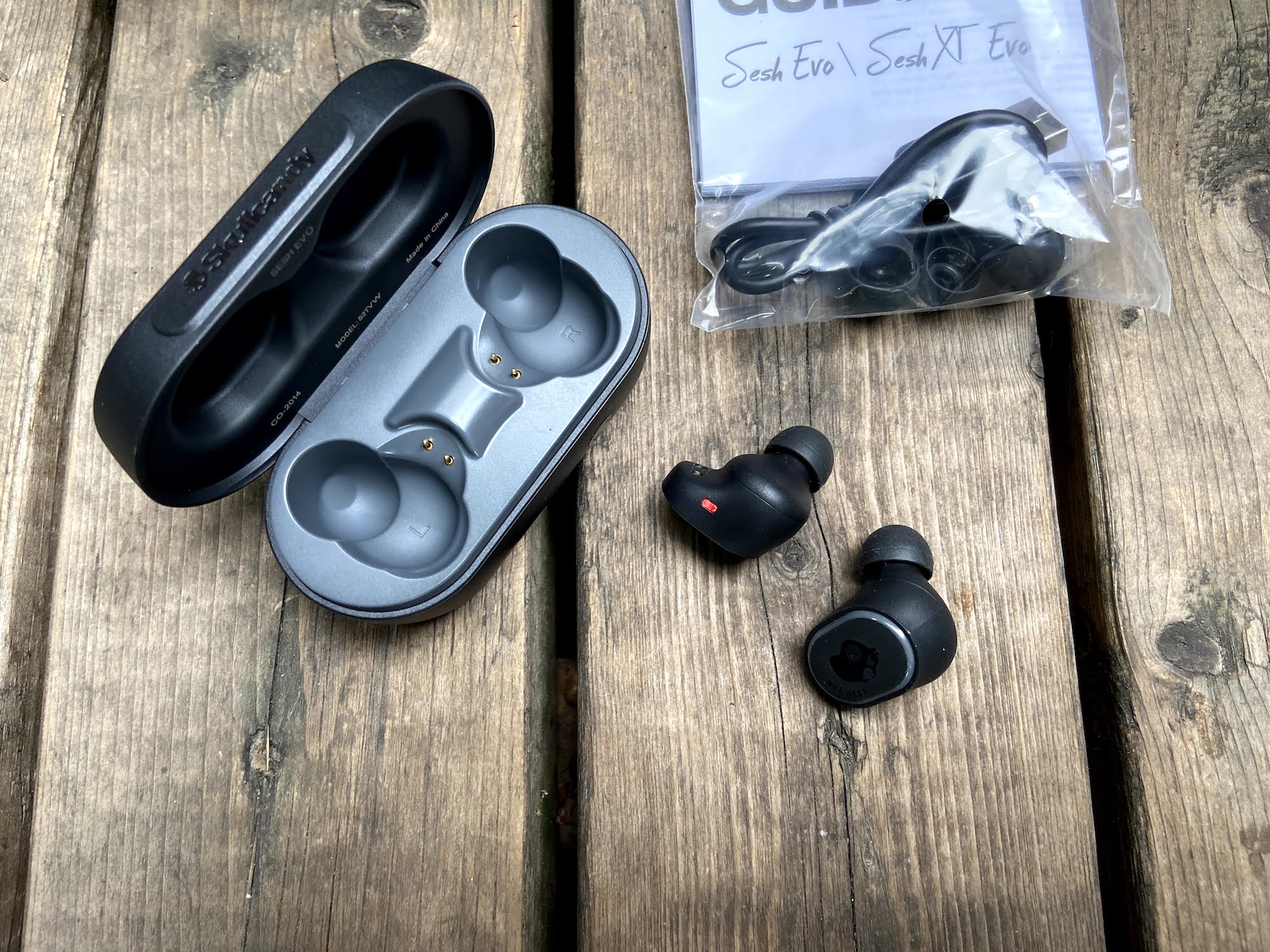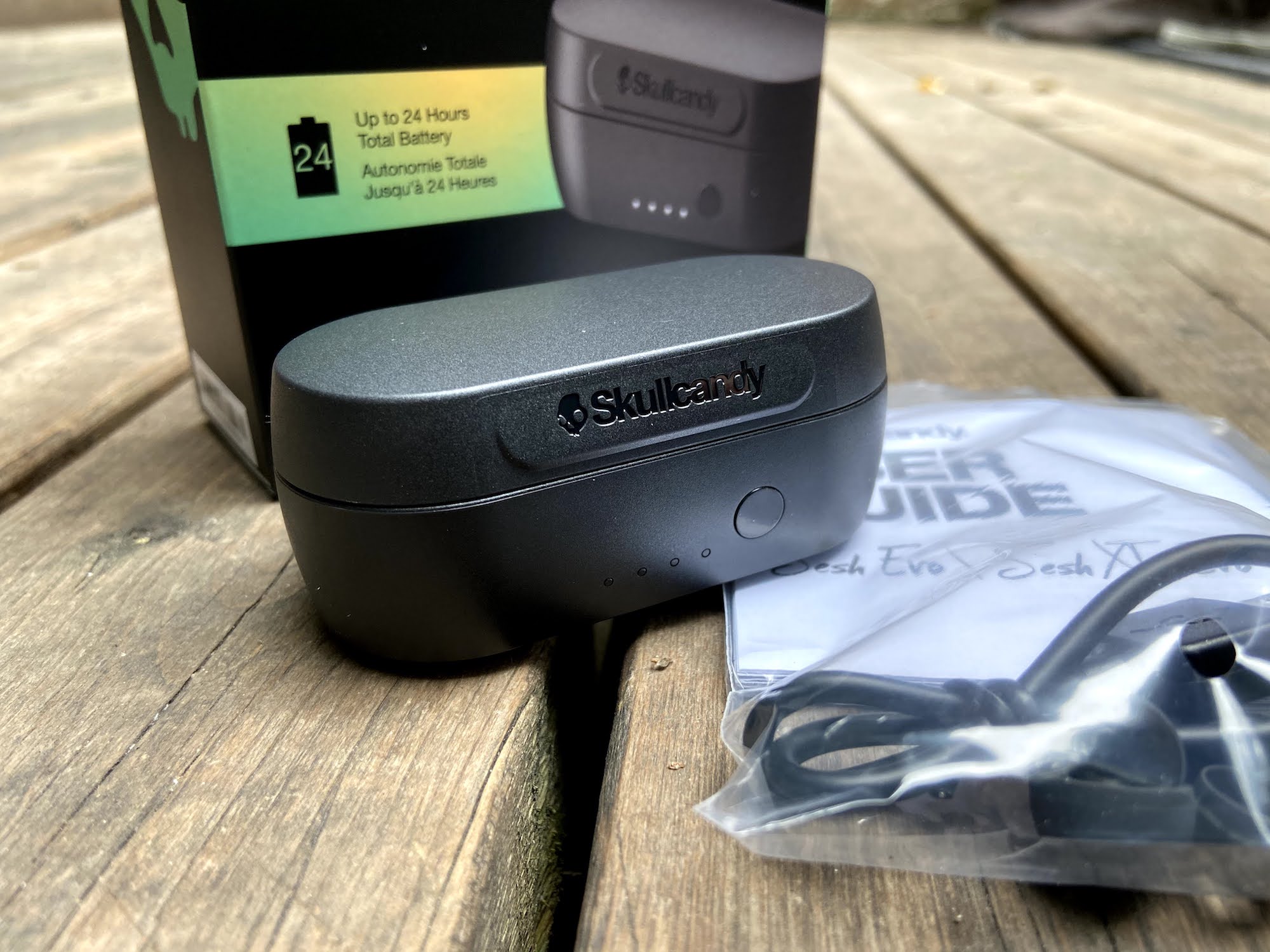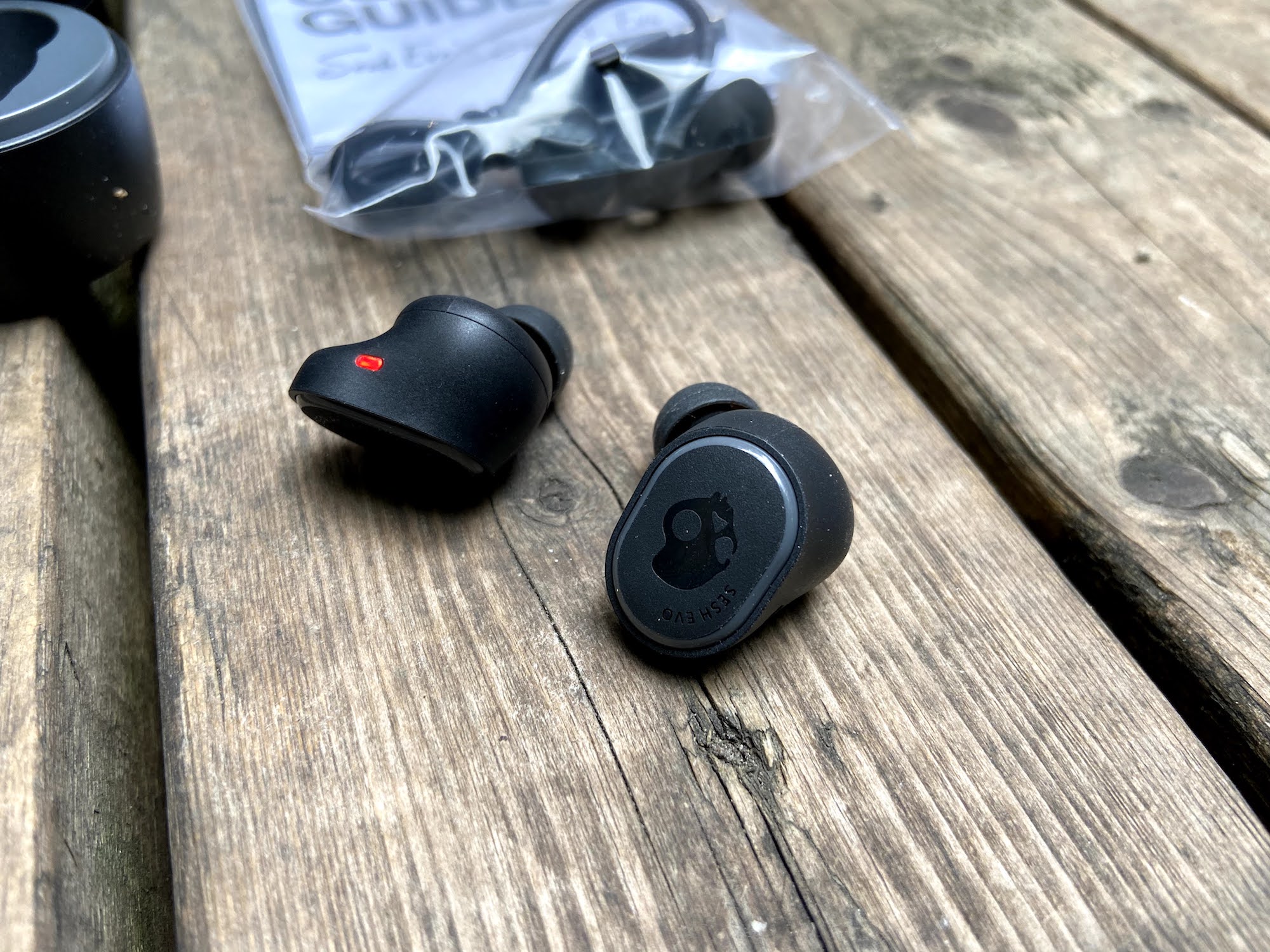“Convenient Tile tracking helps these sporty earbuds justify their $60 price.”
- Well-priced
- Handy Tile tracking
- Multiple colors
- Poor call quality
- Mediocre battery life
Skullcandy has been doing an admirable job of providing affordable and stylish true wireless earbuds for those who refuse to pay the Apple premium — or who simply want something different from those ubiquitous white earbuds.
Its latest offering is the $60 Sesh Evo — a step up from its $50 Sesh — a no-nonsense set of
Thanks to an ongoing partnership with Tile, they have one feature that no other brand of true wireless buds can claim: The ability for you to track and find them should you misplace them.
Is it enough to differentiate the Sesh Evo from an Amazon-sized tsunami of $60 earbuds?
Let’s check them out.
What’s in the box?

Skullcandy’s packaging still needs an upgrade from a sustainability point of view. Inside the cardboard outer box is a black plastic tray lined with black foam padding. Even if the plastic were easy to recycle curbside where you live, the foam would need to be removed and discarded first.
Sitting in the tray, you’ll find the Sesh Evo buds (fitted with the medium eartips) and their charging case. A resealable polybag contains a nine-inch USB-C charging cord, two extra sizes of eartips, and a small printed quick-start guide.
Design
The Sesh Evo come in four colors — black, red, light blue, and light green, which is a refreshing change from the usual white or black options most companies offer.
A satin-like plastic is used for both the earbuds and the charging case — it’s virtually the same finish you’ll find on all
Several seams are visible on the earbud shells, but despite this, they carry an IP55 rating for dust and water resistance, which is more than enough to handle the most strenuous of workouts — and a good deal more protection than you get from Apple’s AirPods, or Samsung’s Galaxy Buds.
The earbuds have an asymmetrical oval shape, with a discrete skull logo on a rubber membrane outer surface that you press to trigger the physical button control.
An LED on the sides of the earbuds lights up red when they’re in the charging case to let you know they’re seated correctly and getting a charge, and it will also let you know when the buds are in pairing mode.
The charging case isn’t the largest I’ve ever seen, but its wide, boxy shape makes it awkward for pocketing. If you carry a purse, backpack, or another tote, at least it will be easy to find.
The flip-top lid is easy to open and snaps closed firmly thanks to a powerful magnet. The charging sockets themselves also have very good magnetic contacts, but you’ll need to make sure the red charging light comes on — especially when using the larger eartips, the Sesh Evo don’t always seat themselves perfectly without a bit of help.
You’ll find the USB-C charging port on the backside, while a small button on the front lets you momentarily trigger the four-LED charging indicator to see how much juice is left in the case.
Overall, the Sesh Evo are well-designed and functional
Comfort, controls, and connections

I found the Sesh Evo to be average in terms of fit and comfort for a set of in-ear
The buttons take a fair amount of pressure to activate, which isn’t so ideal.
The three sizes of eartips is below average, and though this will probably offer most folks the range they need to get a good seal, if you have particularly sensitive or small ear canals, it can feel like the worst place to cut costs. We’d like to see at least four total eartip options going forward from every manufacturer.
As with most in-ear designs, a certain amount of twisting is required. They’re meant to sit in the ear with the skull logo upright — that is if the models on the Skullcandy website are any indication.
For me, the most comfortable position was a slightly backward-leaning angle.
Once wedged into my ear canal, they sat very securely — I felt no need at all for an additional earfin or other supports.
But using the controls on the earbuds was slightly less satisfying. Regular Digital Trends readers know I prefer physical buttons to touch-based controls on
The button mechanism sits under a membrane, which keeps them safe from dust and water, but it also makes them harder to press. After some trial and error, I found the easiest way to use them was to press a finger against the membrane, then press a little harder until it triggered the mechanism. It’s kind of like the press-halfway-to-focus system on camera shutter buttons.
It still has all of the benefits of physical buttons (no accidental triggering and a discernible click for feedback), but if you end up doing a lot of these presses, you’ll probably get sore over time.
On a positive note, the control scheme is highly intuitive and covers all the essentials: Volume up/down, play/pause, track skip forward/back, call answer/end, and voice assistant access (Siri/Google Assistant).
You can also use the buttons to power the buds on or off independently from their charging case.
The Sesh Evo use Bluetooth 5.0, which I’ve found to be very reliable for both pairing and overall connection quality. You can pair the buds to multiple devices, but only one device can be paired at a time.
Their quick-charge feature is excellent, with 10 minutes of socket time giving back two hours of play time.
It’s also possible to use the earbuds individually, but keep in mind that some controls like volume up/down and track skip forward/back rely on the use of two earbuds.
Battery life

Battery life for the Sesh Evo is somewhat disappointing by today’s standards. They get five hours of playtime between trips back to the charging case, which is on the low end of the spectrum. Meanwhile, the charging case carries three full recharges, for a total of 20 hours — also a few hours short of what I’d expect.
The good news is that their quick-charge feature is excellent, with 10 minutes of socket time giving back two hours of play time.
So while you’ll find plenty of other models that offer more battery life, the Sesh Evo will still get you through a full day unless you’re using them nonstop for more than five hours at a time.
Sound quality

Within its price range, the Sesh Evo delivers acceptable performance sound-wise. They won’t blow you away, but neither will they disappoint, especially if you’re not expecting audiophile quality.
The most critical thing is to get a good seal with the available eartips. Without this, the earbuds will sound downright dreadful — both hollow and tinny.
This is trickier than it seems. I found that what felt like a very good fit initially wasn’t adequate once I started playing music. A bit of extra twisting and turning until you find the right angle is probably required.
You’ll know you’ve got it right when you hear bass that feels full, not hollow. Keep trying until you get there.
Overall frequency response is decent — you get the lows, mids, and highs at sufficient levels where it doesn’t feel like anything’s missing. But the separation between these frequencies isn’t as cleanly defined as with some of the best performers at this price.
They also lack a bit of liveliness, especially around vocals. If your taste runs toward hard rock, punk, or metal, these genres can overcome this limitation through pure power alone. But music that requires a deft touch like jazz, folk, or classical won’t quite live up to its full potential.
Accessing the Sesh Evo’s built-in three-mode EQ (music, movie, podcast) can help to liven up the highs — particularly when in podcast mode — but only at the cost of losing some of the low-end bass.
Looking for a workout companion, or something to help the commute go by a little less painfully? The Sesh Evo are more than suitable. But for a more faithful music partner, I’d look at the $79 Earfun Air, which you can usually find for about $50.
Tile tracking

While I’m not so convinced that a big set of cans like the Crushers benefit from the feature,
Even when tucked into their charging case, they’re small enough to be lost between couch cushions or accidentally left sitting on a restaurant table. Heck, just trying to remember where you last sat them down in your own home could prove challenging.
The Tile functionality works perfectly. Once you’ve registered the Sesh Evo with the Tile app — a quick and painless process — you can use the app’s Find button to trigger a high-pitched whistle from the earbuds that grows louder the longer it runs.
Better yet, as long as the left earbud still has some battery power left (it maintains the Tile connection), you can trigger the location sound whether the earbuds are powered on or off, or inside their charging case or lying around on their own.
The Tile functionality works perfectly.
As long as you’re not in an especially noisy environment, you should be able to hear the distinctive whistle from up to 20 feet away — possibly more if the buds aren’t in their case.
The Tile feature can’t guarantee your lost earbuds will always make their way back to you, but it increases the odds dramatically.
Call quality
Call quality on the Sesh Evo is about what you can expect from a set of inexpensive earbuds. You can certainly make and take calls using them, but you’ll have to speak very clearly and maybe a bit louder than you’d like to ensure your voice is heard.

You’ll probably end up speaking louder anyway because there’s no transparency/ambient mode to pipe your voice into the earbuds in order to overcome the eardrum seal of the silicone tips.
Even then, nearby sounds like traffic — and especially heavy traffic or loud commercial vehicles — will regularly drown you out, making it difficult for your callers to hear you.
Indoor calling is adequate, but overall, I wouldn’t rely on these earbuds for mission-critical business calls.
Our take
The Sesh Evo deliver a good true wireless experience for the price, but their unique and handy Tile tracking feature helps them stand out (literally) from the crowd.
Is there a better alternative?
Skullcandy has found a sweet spot in terms of price for the Sesh Evo — there aren’t a lot of
Still, if you like the Sesh Evo’s design and don’t mind sacrificing Tile tracking and some battery life, the regular Skullcandy Sesh are now $50 or less.
The Earfun Free are also $50 or less, and they have slightly better sound and wireless charging.
For significantly better sound, and only a few dollars more, the Earfun Air are an excellent alternative.
How long will they last?
Skullcandy products are generally quite durable and the Sesh Evo look to be well-made. Their IP55 rating and a healthy two-year warranty from Skullcandy definitely provide peace of mind.
It’s also worth noting that Skullcandy’s “Fearless Use Promise” lets you buy replacement earbuds at a discounted price should you ever lose or damage one or both.
Should you buy them?
Yes. For $60, the Sesh Evo offer a good mix of features and performance.







